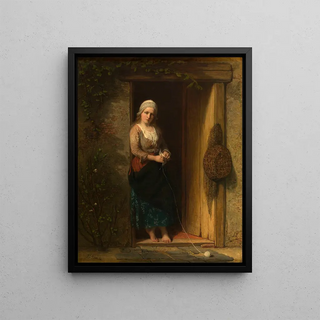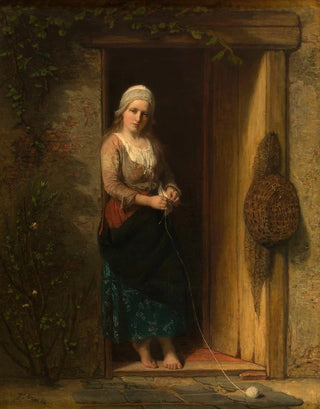Art print | Ida, the fisherman's daughter at the door - Jozef Israëls


View from behind

Frame (optional)
In the world of art, some artworks manage to capture the very essence of everyday life while revealing deep emotions and silent stories. "Ida, the daughter of the fisherman at the door" by Jozef Israëls is one of those creations that transcends the simple pictorial frame. This piece, imbued with melancholy and tenderness, immerses us in the intimate universe of a young girl, symbol of innocence and simplicity. Through this painting, Israëls invites us to contemplate not only the beauty of his subject but also the depth of human relationships and the fragility of life.
Style and uniqueness of the work
Jozef Israëls' style is distinguished by his ability to blend realism with a touch of impressionism, creating an almost poetic atmosphere. In "Ida, the daughter of the fisherman at the door," light plays a fundamental role. Delicate nuances and subtle shadows give the scene striking depth. The gaze of the young girl, both dreamy and contemplative, immediately captures attention. Her posture, both natural and meaningful, evokes a moment of pause, a reflection on her future. The details of the setting, though simple, are carefully observed, reflecting the importance of daily life in Israëls' work. Every element, from the fishing net to the house walls, contributes to a visual narration that transports us into a suspended moment.
The artist and his influence
Jozef Israëls, an emblematic figure of the Hague School, left his mark on his era through his humanist approach and his commitment to the working classes. His works, often inspired by fishermen and laborers, testify to a rare sensitivity to the human condition. Israëls was also influenced by past masters, such as Rembrandt, from whom he mastered the technique of light to evoke emotion. His ability to depict scenes of daily life with such depth of soul made him a pioneer in representing modest subjects. "Ida, the daughter of the

Matte finish

View from behind

Frame (optional)
In the world of art, some artworks manage to capture the very essence of everyday life while revealing deep emotions and silent stories. "Ida, the daughter of the fisherman at the door" by Jozef Israëls is one of those creations that transcends the simple pictorial frame. This piece, imbued with melancholy and tenderness, immerses us in the intimate universe of a young girl, symbol of innocence and simplicity. Through this painting, Israëls invites us to contemplate not only the beauty of his subject but also the depth of human relationships and the fragility of life.
Style and uniqueness of the work
Jozef Israëls' style is distinguished by his ability to blend realism with a touch of impressionism, creating an almost poetic atmosphere. In "Ida, the daughter of the fisherman at the door," light plays a fundamental role. Delicate nuances and subtle shadows give the scene striking depth. The gaze of the young girl, both dreamy and contemplative, immediately captures attention. Her posture, both natural and meaningful, evokes a moment of pause, a reflection on her future. The details of the setting, though simple, are carefully observed, reflecting the importance of daily life in Israëls' work. Every element, from the fishing net to the house walls, contributes to a visual narration that transports us into a suspended moment.
The artist and his influence
Jozef Israëls, an emblematic figure of the Hague School, left his mark on his era through his humanist approach and his commitment to the working classes. His works, often inspired by fishermen and laborers, testify to a rare sensitivity to the human condition. Israëls was also influenced by past masters, such as Rembrandt, from whom he mastered the technique of light to evoke emotion. His ability to depict scenes of daily life with such depth of soul made him a pioneer in representing modest subjects. "Ida, the daughter of the






